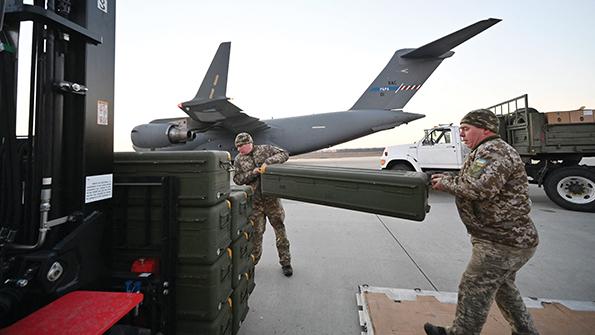
Wars teach many lessons. Most are harsh, many are forgotten after previous conflicts, and some are plain false. Among the latter, the U.S. and its allies returned from Iraq and Afghanistan with unrealistic (or to be more generous, nontransferable) ideas about air operations. They took air dominance as a given, with air support (whether fighter jets or attack helicopters) on call 24/7 and an ability to maneuver sometimes large formations of helicopters at will over large expanses and wholly unmolested until the last minute of the landing phase or takeoff.
The Ukraine war is turning such cozy assumptions on their heads. The upper airspace over Ukraine clearly belongs largely to Russian triple-digit (S200/300/400) surface-to-air missiles (SAM). No close air support aircraft can loiter there. And U.S. and European deliveries of very short-range man-portable air defense missiles (Manpads) have turned the airspace below 3,000 ft. into a no-go zone for Russian aircraft and helicopters.
These unpleasant reminders of the realities of high-intensity warfare against near-peer adversaries are in turn undermining the case for further investment in and maintenance of Western air assault capabilities, whether fixed- or rotary-wing.
Russia started the war with apparently strong air assault capabilities. Such desant operations have been a core element of Russian (and previously Soviet) doctrine since the Cold War. But the failure of the Hostomel Airport operation (one that all too closely resembled U.S., UK and French air assault doctrines and practice) should have been a shock to many observers. The Ukrainians reinforced more quickly, denying the Russians the all-important but oft-overlooked rapid- and follow-on air/land phases. Artillery and Manpads made sorties by a mix of Ilyushin Il-76 transports and attack and assault helicopters too dangerous.
Since those early days of the war, the air defenses of both sides have had a clear deterrent effect on helicopter operations. This has had the greatest impact on Russia, which expected attack helicopters to roam far and wide in support of its armored thrusts. Ukraine’s operations therefore look like a valuable template for future wars: Armies have become smaller, and their deployments are both dispersed and fragmented—there is no “front line” anymore. But the battlefield also has become more technologically dense, especially with sensors and missile systems. Absent air superiority, it is an especially harsh environment for helicopters and sweeping airborne maneuvers.
The case for future investment in attack and armed reconnaissance helicopters was weakening before the invasion of Ukraine. A major part of their role, surveillance and missile attack on ground targets, is increasingly being assumed by armed UAVs. That these are less operationally flexible and still vulnerable is arguably far less important than hard economics. The price per UAV can be as little as 1/20th that of a new-build Boeing AH-64 Apache, and a UAV has an even smaller logistics footprint.
The other challenge is the need for greater protection of crewed air assets deployed at low altitudes over a fragmented battlefield. Cockpit armor directly subtracts from payload, and directed-energy countermeasures demand electrical power and storage from airframes that have little to spare. Attack and assault helicopter designs will have to become physically larger and hence more expensive.
Interestingly, the U.S. Air Force has been the first to acknowledge this new scenario with its curtailment of the Sikorsky HH-60W Jolly Green II combat search-and-rescue helicopter program due to the helicopter’s lack of survivability over current battlefields.
Western defense budgets—even in Germany, whose proposed €100 billion ($105 billion) equipment plus-up equates to nearly twice its annual pre-war defense spending—are likely to remain under pressure, given the costs of reversing the downsizing and hollowing out of conventional forces over the last three decades. We see investment priorities focusing on core areas of air defense, UAVs, armor and indirect fire. Air assault operations are likely to be relegated by both the U.S. and European nations to niche roles in out-of-area operations, sealing off penetrations in defense.
Boeing, therefore, probably will retain its dominance over this shrinking market. The AH-64E is the clear choice for attack helicopters this decade. But of the two new U.S. vertical-lift programs, the justification for the Future Attack Reconnaissance Aircraft looks especially weak, and the market size for the Future Long-Range Assault Aircraft will most likely shrink.
The two European manufacturers, Airbus and Leonardo, have achieved civil helicopter leadership despite the commercial failure of their attack helicopter product lines (the Tiger and A-129 Mangusta, respectively). They would be ill-advised to throw good money after bad to maintain a presence in a segment that is in such flux.






Comments
There is however still the need to insert special forces into areas controlled by a peer enemy. Out of the box thinking will be necessary to do this. A stealth glider, towed to altitude and released well away from the front line, could fill the bill. Stealth would defeat the radar guided mid-altitude SAM threat and the lack of engines would render most MANPADS, which guide on IR, ineffective. Operations would, to avoid visual interception by fighter aircraft, be limited to night only.
SAG